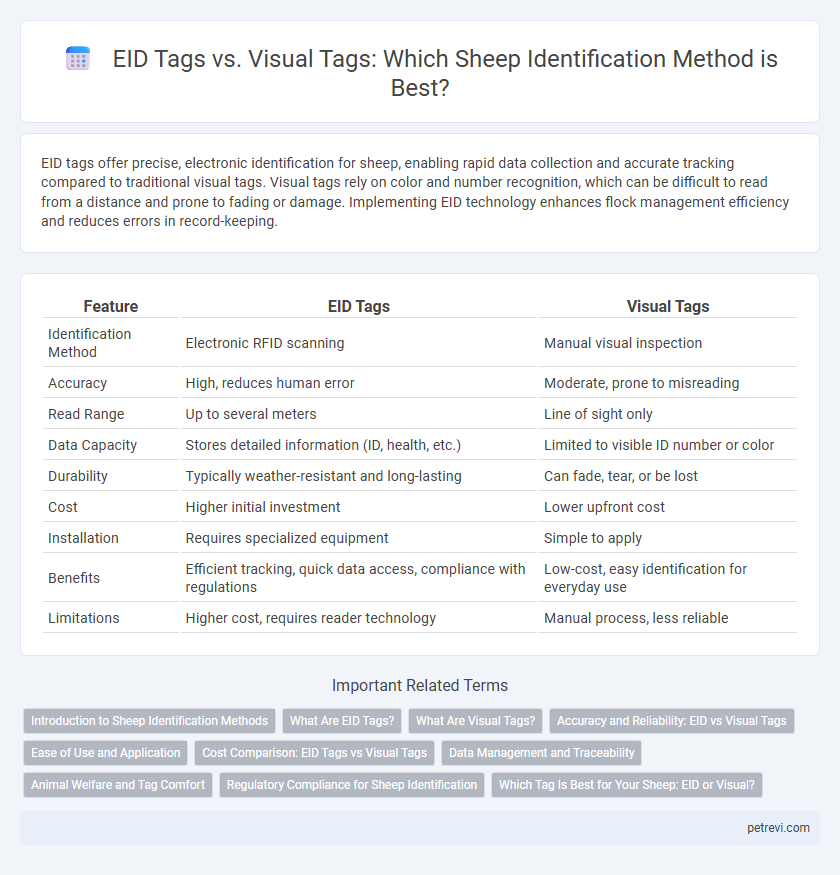EID tags offer precise, electronic identification for sheep, enabling rapid data collection and accurate tracking compared to traditional visual tags. Visual tags rely on color and number recognition, which can be difficult to read from a distance and prone to fading or damage. Implementing EID technology enhances flock management efficiency and reduces errors in record-keeping.
Table of Comparison
| Feature | EID Tags | Visual Tags |
|---|---|---|
| Identification Method | Electronic RFID scanning | Manual visual inspection |
| Accuracy | High, reduces human error | Moderate, prone to misreading |
| Read Range | Up to several meters | Line of sight only |
| Data Capacity | Stores detailed information (ID, health, etc.) | Limited to visible ID number or color |
| Durability | Typically weather-resistant and long-lasting | Can fade, tear, or be lost |
| Cost | Higher initial investment | Lower upfront cost |
| Installation | Requires specialized equipment | Simple to apply |
| Benefits | Efficient tracking, quick data access, compliance with regulations | Low-cost, easy identification for everyday use |
| Limitations | Higher cost, requires reader technology | Manual process, less reliable |
Introduction to Sheep Identification Methods
Electronic Identification (EID) tags provide precise, automated tracking of sheep through radio frequency identification technology, enhancing data collection for flock management. Visual tags, while more traditional, offer a cost-effective and immediate way to identify sheep but rely on manual reading and increase the risk of human error. Integrating EID tags into sheep identification systems improves accuracy, traceability, and compliance with livestock regulations.
What Are EID Tags?
EID (Electronic Identification) tags for sheep are small, tamper-proof devices embedded with microchips that store unique identification data, allowing for efficient animal tracking and management through RFID (Radio Frequency Identification) readers. These tags enhance traceability, improve record accuracy, and facilitate compliance with livestock regulations compared to traditional visual tags, which rely on easily visible but less secure marking methods. EID tags significantly reduce errors in sheep identification by automating data collection during health checks, transport, and breeding processes.
What Are Visual Tags?
Visual tags for sheep identification are brightly colored plastic or metal identifiers attached to the animal's ear, designed to provide immediate, easy-to-read information such as flock number or individual ID. Unlike Electronic Identification (EID) tags, which use microchips for digital tracking and data collection, visual tags offer a straightforward, low-cost solution ideal for quick visual management on farms. These tags improve operational efficiency by allowing farmers to instantly recognize and sort sheep without the need for specialized scanning equipment.
Accuracy and Reliability: EID vs Visual Tags
EID tags offer higher accuracy and reliability in sheep identification by enabling automated, error-free data capture through radio frequency technology, reducing human error common with visual tags. Visual tags depend on manual reading, which can lead to misidentification in poor visibility or with worn tags, compromising data consistency. The electronic nature of EID tags ensures durability and precise tracking, essential for effective flock management and regulatory compliance.
Ease of Use and Application
EID tags offer streamlined sheep identification with automated scanning, reducing manual errors and speeding up data collection compared to visual tags. Visual tags are simpler to apply and cost-effective, but require close inspection, which can be time-consuming and less reliable for large flocks. Choosing between EID and visual tags depends on flock size, budget, and the need for precise, real-time data management.
Cost Comparison: EID Tags vs Visual Tags
EID tags for sheep identification generally have a higher upfront cost, ranging from $1.50 to $5 per tag, compared to visual tags, which typically cost between $0.10 and $0.50 each. However, EID tags offer long-term savings through improved tracking accuracy, reduced labor for manual counting, and prevention of misidentification errors. Visual tags require frequent replacement due to wear and loss, potentially increasing overall expenses despite their lower initial price.
Data Management and Traceability
EID tags enhance data management and traceability in sheep identification by enabling quick, accurate electronic recording of individual animal information, reducing human error compared to visual tags. These tags integrate seamlessly with digital livestock management systems, allowing for real-time tracking of health records, movement, and breeding data. Visual tags, while cost-effective and easy to apply, lack the precision and efficiency of EID technology in comprehensive data capture and automated traceability processes.
Animal Welfare and Tag Comfort
EID tags offer enhanced accuracy for sheep identification without compromising animal welfare, as they are lightweight and designed to minimize irritation or injury. Visual tags, while more visible, can sometimes cause discomfort or ear damage due to their size and material, potentially affecting sheep behavior and health. Prioritizing tag comfort through flexible, hypoallergenic materials in EID tags supports better welfare outcomes and reliable data collection.
Regulatory Compliance for Sheep Identification
EID tags for sheep identification offer superior regulatory compliance by enabling electronic data capture and traceability required by livestock authorities. Visual tags provide basic identification but lack the automated data integration necessary for meeting stringent government traceability mandates. Adoption of EID tags ensures adherence to national and international livestock identification standards, enhancing disease control and livestock management efforts.
Which Tag Is Best for Your Sheep: EID or Visual?
EID tags offer precise electronic identification for sheep, enabling efficient tracking and data management through RFID technology, which enhances flock monitoring and disease control. Visual tags provide a cost-effective, immediate method for identifying individual sheep, especially useful in small-scale or low-tech operations where quick visual checks are essential. Choosing between EID and visual tags depends on flock size, management goals, and budget, with EID best suited for large-scale, data-driven operations and visual tags ideal for smaller, simpler identification needs.
EID Tags vs Visual Tags for Sheep Identification Infographic

 petrevi.com
petrevi.com